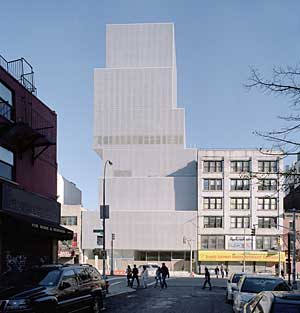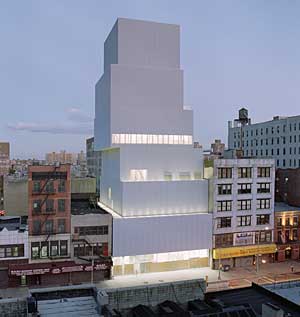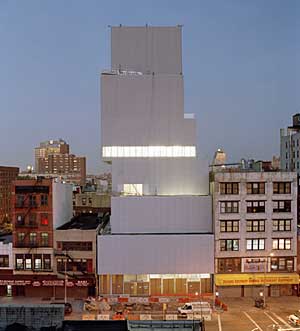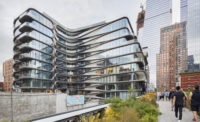The design for the New Museum, which the Tokyo-based firm Sejima + Nishizawa/Sanaa first revealed in 2003 for New York City’s only all-contemporary art institution, layers six off-kilter white boxes above a formerly grungy block on the Lower East Side. That striking shape led many people to expect a show-offy building. But its architects hope that when the $50 million, 60,000-square-foot museum officially opens this weekend, visitors and passersby will instead be struck by its neighborly spirit. The shift of each box creates space for a terrace or skylight, providing views of surrounding buildings from each stairwell, while its ground floor engages the street with transparency.


Sanaa’s New Museum, photographed in September as constructed neared completion, opens this weekend. An expanded-aluminum mesh projects as a screen three inches off the steel-and-concrete facade. At night, the glass-walled lobby and first floor galleries will allow views of the artwork.
“The museum wanted to keep everything as open as possible,” says Sanaa project architect Florian Idenburg. The designers satisfied this demand with gestures such as a lobby whose glass panes meet the sidewalk as they descend into trenches, and a first floor with open vistas of ground-floor galleries and a freight elevator. Video installations on this level will probably run all night, says co-project architect Toshi Oki, so that “at 3 o’clock in the morning you will see the art from the street.”
Also visible from the street, most strikingly along the building’s west elevation, is a cladding that might become the museum’s signature: an expanded-aluminum mesh that projects as a screen three inches off the steel-and-concrete facade. The architects say they chose the material, commissioned from a British firm called Expamet, for its potential to deflect light into the museum. But they also expect it will add to the client’s branding. The same mesh defines a curtain in the tight first floor that the architects designed to seal off a small retail area. “The shape is so aggressive,” Oki explains, “it can become a symbol of the museum, like the shape of the building.” The silhouette is an echo, of sorts, of the Whitney and Guggenheim buildings uptown, and it dominates the New Museum’s marketing material.
The New Museum’s four gallery floors provide different envelopes for traveling and temporary shows: mechanical systems are concentrated at the core allowing for column-free space. The fifth floor contains classrooms, and computer space for an online learning program, while offices occupy the sixth floor. On the seventh story sits a 2,000-square-foot event space with a wraparound terrace. The architects joke that the museum may recoup its investment by renting out that floor, which offers dramatic views across Manhattan and the East River. In another move intended to help the museum remain tied to its context, the architects added a sixth-floor window mainly because it neatly frames a view of the Empire State Building.

Photo © Dean Kaufman


Post a comment to this article
Report Abusive Comment